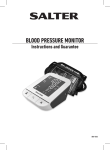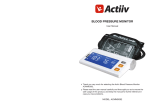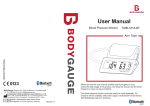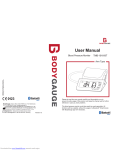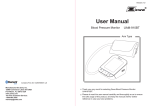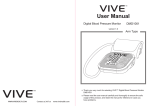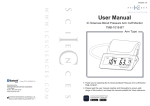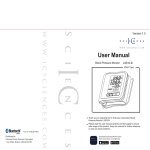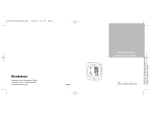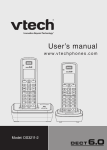Download User Manual
Transcript
Version:1.0 User Manual Wrist Blood Pressure Monitor EBP-017 Wrist Type EASY AT HOME MEDICAL,LLC Any questions,please call toll-free : 1-855-822-6999 M-F 9 a.m.-5 p.m. CST E-MAIL:[email protected] Thank you very much for selecting EBP-017. Wrist Blood Pressure Monitor Please do read the user manual carefully and thoroughly so as to ensure the safe usage of this product. Please keep this manual in order to reference in future. CATALOGUE INTRODUCTION Table of Contents General Description INTRODUCTION ............................................................... 1 General Description Safety Information LCD Display Signal Monitor Components Thank you for selecting wrist type blood pressure Monitor (EBP-017). The monitor features blood pressure measurement, pulse rate measurement and the result storage. The design provides you with two years of reliable service. BEFORE YOU START .......................................................... 5 Installing and Replacing the Batteries Setting Date, Time and Measurement Unit This manual contains important safety and care information, and provides step-bystep instructions for using the product. MEASUREMENT ............................................................... 8 Tie the Cuff Start Measurement FEATURES: Systolic Blood Pressure Diastolic Blood Pressure DATA MANAGEMENT .......................................................... 10 Recall the Records Delete the Records INFORMATION FOR USER ..................................................... 13 Tips for Measurement Maintenance ABOUT BLOOD PRESSURE.................................................... 15 What are systolic pressure and diastolic pressure? What is the standard blood pressure classification? Why does my blood pressure fluctuate throughout the day? Why do I get a different blood pressure at home compared to the hospital? Is the result the same if measuring on the right wrist? TROUBLESHOOTING ......................................................... 17 SPECIFICATIONS ............................................................. 18 CONTACT INFORMATION...................................................... 19 COMPLIED STANDARDS LIST ......................................19 FCC STATEMENT ............................................................. 20 EMC GUIDANCE ............................................................. 20 Readings taken by the EBP-017 are equivalent to those obtained by a trained observer using the cuff and stethoscope auscultation method. Read the manual thoroughly before using the product. Pulse Rate Memory: Up to 60 pieces of records Safety Information The signs below might be in the user manual, labeling or other components. They are the requirement of standard and using. Symbol for “THE OPERATION GUIDE MUST BE READ” Symbol for “SERIAL NUMBER” Symbol for “MANUFACTURER” Symbol for “DIRECT CURRENT” Symbol for “TYPE B APPLIED PARTS” Symbol for “ENVIRONMENT PROTECTION - Electrical waste products should not be disposed of with household waste. Please recycle where facilities exist. Check with your local authority or retailer for recycling advice” Symbol for “MANUFACTURE DATE” 1 INTRODUCTION CAUTION This device is intended for adult use only. This device is intended for non-invasive measuring and monitoring of arterial blood pressure. It is not intended for use on extremities other than the wrist or for functions other than obtaining a blood pressure measurement. Do not confuse self-monitoring with self-diagnosis. This unit allows you to monitor your blood pressure.Do not begin or end medical treatment without asking a physician for treatment advice. If you are taking medication,consult your physician to determine the most appropriate time to measure your blood pressure. Never change a prescribed medication without consulting your physician. If the cuff pressure exceeds 40 kPa (300 mmHg),the unit will automatically deflate. Should the cuff not deflate when pressures exceeds 40 kPa (300 mmHg), detach the cuff from the wrist and press the START/STOP button to stop inflation. To avoid measurement errors, carefully read this manual before using the product. The equipment is not AP/APG equipment and not suitable for use in the presence of a flammable anesthetic mixture with air of with oxygen or nitrous oxide. The operator shall not touch output of batteries and the patient simultaneously. Do not use the monitor under the conditions of strong electromagnetic field (e.g. medical RF equipment) that radiates interference signal or electrical fast transient / burst signal. The user must check that the equipment functions safely and see that it is in proper working condition before being used. Please use ACCESSORIES and detachable partes specified/ authorised by MANUFACTURE. Otherwise, it may cause damage to the unit or danger to the user/patients. Manufacturer will make available on request circuit diagrams, component parts list etc. This unit is not suitable for continuous monitoring during medical emergencies or operations. Otherwise, the patient’s wrist and fingers will become anaesthetic, swollen and even purple due to a lack of blood. Please use the device under the environment which was provided in the user manual. Otherwise, the performance and lifetime of the device will be impacted and reduced. During use, the patient will be in contact with the cuff.The materials of the cuff have been tested and found to comply with requirements of ISO 10993-5:2009 and ISO 10993-10:2010. It will not cause any potential alergic reaction or contact injury. The device doesn’t need to be calibrated within the two years of reliable service. Please dispose of ACCESSORIES, detachable parts, and the ME EQUIPMENT according to the local guidelines. When the device was used to measure patients who have common arrhythmias such as atrial or ventricular premature beats or atrial fibrillation, the best result may occur with deviation. Please consult your physician about the result. This device is contraindicated for any female subject who may be suspected of, or is pregnant. Besides providing inaccurate readings, the effects of this device on the fetus are unknown. The device has been evaluated clinically using manual cuff/stethoscope auscultation as the reference. Blood pressure measurements determined with this device are equivalent to those obtained by a trained observer using the cuff/stethoscope auscultatory method, within the limits prescribed by the American National Standard, Manual, electronic, or automated sphygmomanometers.” 2 INTRODUCTION LCD Display Signal SYMBOL DESCRIPTION EXPLANATION Systolic blood pressure High pressure result Diastolic blood pressure Low pressure result BPM Pulse/minute; heartbeats/minute Memory The displayed measurement values is from the memory. Movement error symbol Shocking will result in inaccurate Low battery Batteries are low and need to be replaced mmHg Measurement unit of the blood pressure (1kPa=7.5mmHg) Measurement unit the blood pressure (1mmHg=0.133kPa) Deflating CUFF air is exhausting of deflating kPa Current time Year/Month/Day,Hour/Minute Grade The grade of the blood pressure Arrhythmia Irregular heartbeat Heartbeat Heartbeat detection during the measurement 3 INTRODUCTION BEFORE YOU START Installing and Replacing the Batteries Monitor Components 1.Open the battery door. MEM BUTTON Memory SYSTOLIC LCD DISPLAY SET BUTTON Norm DIASTOLIC Optim GRADE START/STOP BUTTON Time Date PULSE RATE TIME 2.Insert the batteries according to the polarity indications. (Always select the authorized / specified 2×AAA batteries.) 3.Close the battery door. Replace the batteries under following circumstances: CUFF (Type B applied part) displays on the LCD. The LCD display dims. When powering on the monitor, the LCD doesn’t light up. Component List 1.PCBA 2.Air Pipe 3.Pump 4.Valve 5.Cuff BATTERY COMPARTMENT CAUTION Remove batteries if the device is not likely to be used for some time. Worn batteries are harmful to the environment. so please do not dispose with other daily trash. Remove the old batteries from the device following your local recycling guidelines. List 1.Wrist Blood Pressure Monitor (EBP-017) 4 Do not dispose of batteries in fire. Batteries may explode or leak. 2. 2×AAA batteries 3.User manual 5 BEFORE YOU START BEFORE YOU START Setting Date, Time and Measurement Unit Please proceed to time setting before your initial use so as to ensure each piece of record are labled with a time stamp. (Year Range: 2010-2050) 1.When the monitor is OFF, press the SET button to enter into the clock mode, then press and hold “SET” button for about 3 seconds to enter year setting. 4.Repeat steps 2 and 3 to set the [MONTH] and [DAY]. Then it will enter into time format setting. 5.Select the 24 hours time format or the 12 hours time format. Repeat steps 2 and 3 to set the [HOUR] and [MINUTE]. 2.Press “MEM” button to change the numeral. Each press will increase the numeral by one in a cycling manner. 3.Press “SET” button to confirm the [YEAR]. Then the monitor diverts to [MONTH] and [DAY] setting. 6.Repeat steps 2 and 3 to set the measurement unit. 7.After confirming the meausrement unit, the LCD will display all the settings you have done one by one and the monitor will shut off. 6 7 MEASUREMENT MEASUREMENT Tie the Cuff Start Measurement 1 .Remove all accessories (watch, bracelet, etc) from your left wrist. If your 1.After correctly positioning the cuff, press START/STOP button to turn on the monitor, and it will complete the measurement process. physician has diagnosed you with poor circulation in your left wrist, use your right wrist. 2.Roll or push up your sleeve to expose the skin. 3.Apply the cuff to your left wrist with your palm facing up. 4. Position the edge of the cuff about 1-1.5cm (0.4 -0.6 ) from wrist joints. 5. Fasten the wrist cuff around your wrist, leaving no extra room between the cuff and your skin. If the cuff is too loose, the measurement will be inaccurate. Rest for 5 minutes before measuring. Wait at least 3 minutes between measurements. This allows your blood circulation to recover. For a meaningful comparison, try to measure under similar conditions. For example, take daily measurement at approximately the same time, on the same wrist, or as directed by a physician. LCD Display. Adjust to zero. Inflating and measuring. Display and save the measuring result. Time Date Optim Norm Keep the BP monitor the same level of your heart 8 2.Press START/STOP button to turn off the monitor. Otherwise, the monitor will shut off within 1 minute. 9 DATA MANAGEMENT DATA MANAGEMENT Recall the Records 3.When there has no record, the LCD displays “---”. 1.When the blood pressure monitor is off, press “MEM” button to access the memory, it will display the latest record first when the records are less than three groups. When there are three or more than three groups ,it will display the average value of the latest three records first. 2. Press “MEM” button again, it will display the latest measurement record. Press “MEM” button to rotate the history records. Press SET button to look back the record. You can check 60 groups of record totally. When it displays the record, it will shutdown in 1minute if has no operation. The exact time and date of the measurement will display alternatively. 10 The corresponding date is January 1st. UP DOWN CAUTION The most recent record (1) is shown first. Each new measurement is assigned to the first (1) record. All other records are pushed back one digit (e.g., 2 becomes 3, and so on), and the last record (60) is dropped from the list. The corresponding time is 10:38. 11 INFORMATION FOR USER DATA MANAGEMENT Delete the Records When you did not obtain the accurate measurement, you can clear all the measuring results by following steps below. Tips for Measurement Measurements may be inaccurate if taken in the following circumstances. 1.Press and hold both the “MEM” button for 3 seconds when the monitor is in the memory recall mode, the flash display “dEL ALL” will show. Within 1 hour after dinner or drinking Immediate measurement after tea, coffee, smoking Within 20 minutes after taking a bath When talking or moving your fingers 2.When the LCD display blinking “dEL ALL”, press “SET” button to confirm clearing. The LCD will display “dEL dONE”, indicating that memory clearing is complete. 3.If you wish to give up clearing, press the START/STOP button to turn off the monitor. In a very cold environment 12 When you want to discharge urine 13 INFORMATIONFOR FORUSER USER INFORMATION ABOUT BLOOD PRESSURE What are systolic pressure and diastolic pressure? Maintenance To obtain the best performance, please follow the instructions below. Norm Opt im Time Date When ventricles contract and pump blood out of the heart, the blood pressure reaches its maximum value in the cycle, which is called systolic pressure. When the ventricles relax, the blood pressure reaches its minimum value in the cycle, which is called diastolic pressure. Systolic Diastolic press relax blood entering vein blood discharging artery What is the standard blood pressure classification? Norm Optim Time Date Put in a dry place and avoid the sunshine No Op rm tim Tim Dat e e Avoid intense shaking and collisions Avoid touching water, clean it with a dry cloth in case. The chart on the right is the standard blood pressure classification published by American Heart Association (AHA). AHA Home Guideline for Upper Limit of Normal BP Norm Optim Time Date Avoid dusty and unstable temperature environment SYS DIA 135 mm Hg 85 mm Hg This chart reflects blood pressure categories defined by American Heart Association. Blood Pressure Category Normal Systolic mmHg (upper#) Diastolic mmHg (lower#) less than 120 and less than 80 Prehypertension 120-139 or 80-89 High Blood Pressure (Hypertension) Stage 1 140-159 or 90-99 160 or higher or 100 or higher Higher than 180 or High Blood Pressure (Hypertension) Stage 2 Hypertensive Crisis (Emergency care needed) Higher than 110 CAUTION Please consult a physician if your measuring result falls outside the range. Please note that only a physician can tell whether your blood pressure value has reached a dangerous point. Norm Optim Norm O ptim Time Date Time Date Use wet cloths to remove dirt Avoid washing the cuff CAUTION • If you have any problems with this device, such as setting up, maintaining or using, please contact the SERVICE PERSONNEL of . Don’t open or repair the device by yourself. • Please report to if any unexpected operation or events occur. 14 Irregular Heartbeat Detector An irregular heartbeat is detected when a heartbeat rhythm varies while the unit is measuring the systolic and diastolic blood pressure.During each measurement, this equipment records the heartbeat intervals and works out the standard deviation. If the calculated value is larger than or equal to 15,the irregular heartbeat symbol appears on the symbol when the measurement results are displayed. CAUTION The appearance of the IHB icon indicates that a pulse irregularity consistent with an irregular heartbeat was detected during measurement. Usually this is NOT a cause for concern. However, if the symbol appears often, we recommend you seek medical advice. Please note that the device does not replace a cardiac examination, but serves to detect pulse irregularities at an early stage. 15 ABOUT BLOOD PRESSURE TROUBLESHOOTING Why does my blood pressure fluctuate throughout the day? 1. Individual blood pressure varies multiple times everyday, it is also affected by the way you tie your cuff and measurement position, so please take the measurement under the same conditions. 2.If the person takes medicine, the pressure will vary more. PROBLEM SYMPTOM No power Low batteries 3.Wait at least 3 minutes for another measurement. Why do I get a different blood pressure at home compared to the hospital? The blood pressure is different even throughout the day due to weather emotion, exercise etc, Also, there is the “white coat” effect, which means blood pressure usually increases in clinical settings. Is the result the same if measuring on the right wrist? It is ok for both wrists, but there will be some different results for different people. We suggest you measure the same wrist every time. 16 This section includes a list of error messages and frequently asked questions for problems you may encounter with your wrist blood pressure monitor. If the products not operating as you think it should, check here before arranging for servicing. What you need to pay attention to when you measure your blood pressure at home: If the cuff is tied properly. If the cuff is too tight or too loose. If the cuff is tied on the wrist. If you feel anxious. Taking 2-3 deep breaths before beginning will be better for measuring. Advice:Relax yourself for 4-5 minutes until you calm down. Error massage Display is dim or will not light up. CHECK THIS REMEDY Batteries are exhausted. Replace with new batteries Batteries are inserted incorrectly. Show on Batteries are low. the display Insert the batteries correctly Replace with new batteries E 1 shows The cuff is not secure. Refasten the cuff and then measure again. E 2 shows The cuff is very tight Refasten the cuff and then measure again. E 3 shows The pressure of the cuff is excess. Relax for a moment and then measure again. E 10 or E 11 shows Movement can affect the The monitor detected measurement.Relax for a motion while measuring. moment and then measure again. E 20 shows The measurement Loosen the clothing on process does not detect the wrist and then the pulse signal. measure again. E 21 shows Measure incorrectly. EExx,shows on the display. A calibration error occurred. Relax for a moment and then measure again. Retake the measurement. If the problem persists, contact the retailer or our customer service department for further assistance.Refer to the warranty for contact information and return instructions. 17 SPECIFICATIONS Power Supply Display Mode CONTACT INFORMATION Contact Information Battery powered mode: 2×AAA batteries (3V) Digital LCD V.A 31.5mm×44mm(1.25’’×1.73’’) Measurement Mode Oscillographic testing mode Measurement Range Pressure: 0kPa-40kPa(0mmHg-300mmHg) pulse value:(40-199)beat/minute Accuracy Pressure: 5℃-40℃(41℉-104℉)within±0.4kPa(3mmHg) pulse value:±5% Normal working condition Temperature:5℃ to 40℃(41℉ to 104℉) Relative humidity: ≤85%RH Atmospheric pressure: 86kPa to 106kPa Storage & transportation condition Temperature:-20℃-60℃ (-4℉ - 140℉) Relative Humidity: 10%RH-93%RH Atmospheric Pressure: 50kPa-106 kPa Measurement perimeter of the wrist About 13.5cm-21.5cm(5 / Weight External dimensions Attachment Mode of operation Degree of protection IP Classification Software version Device classification 1 ” 3 - 81/2 ) ” Approx.112g(3.95oz)(Excluding batteries) Approx. 68mm×75mm×31mm(2.68”×2.95”×1.22”) (Excluding the cuff) 2×AAA batteries,one storage,user manual Continuous operation Type B applied part For more information about our products, please visit , or call Customer 1-866-822-6999 M-F 9 a.m.-5 p.m.CST, usual problems and customer download, will serve you anytime. Complied Standards List Risk management Labeling ISO 14971:2007 EN 980:2008 User manual EN 1041:2008 General Requirements for Safety IEC 60601-1:2005 Electromagnetic compatibility Non-invasive Sphygmomanometers General Requirements IEC 60601-1-2:2007 AASI/AAMI SP10:2002/A1:2003/A2:2006/(R)2008 IP×0 V01 Internally Powered ME Equipment 18 WARNING: No modification of this equipment is allowed. 19 EMC GUIDANCE Table 2 Guidance and MANUFACTURER’s declaration – electromagnetic IMMUNITY – for all ME EQUIPMENT and ME SYSTEMS FCC Statement This device complies with Part 15 of the FCC Rules. Operation is subject to the following two conditions: (1) this device may not cause harmful interference, and (2) this device must accept any interference received, including interference that may cause undesired operation. Guidance and manufacturer’s declaration – electromagnetic immunity The device is intended for use in the electromagnetic environment specified below. The customer or the user of the device should assure that it is used in such an environment IMMUNITY test Electrostatic discharge (ESD) IEC 61000-4-2 EMC Guidance Table 1 Guidance and MANUFACTURER’s declaration – ELECTROMAGNETIC EMISSIONS- for all ME EQUIPMENT and ME SYSTEMS Guidance and manufacturer’s declaration – electromagnetic emissions Electrical fast transient/burst IEC 61000-4-4 Surge IEC 61000-4-5 The device is intended for use in the electromagnetic environment specified below. The customer or the user of the device should assure that it is used in such an environment. Emissions test Compliance Electromagnetic environment - guidance RF emissions CISPR 11 Group 1 The device uses RF energy only for its internal function. Therefore, its RF emissions are very low and are not likely to cause any interference in nearby electronic equipment. RF emissions CISPR 11 Class B Harmonic emissions IEC 61000-3-2 Not applicable Voltage fluctuations/ flicker emissions IEC 61000-3-3 20 Not applicable Voltage dips, short interruptions and voltage variations on power supply input lines IEC 61000-4-11 IEC 60601 test level Compliance level ±6 kV contact ±8 kV air ±2 kV for power supply lines ±1 kV for input/output lines ±1 kV line(s) to line(s) ±2 kV line(s) to earth ±6 kV contact ±8 kV air Not applicable Not applicable <5% UT (>95% dip in UT ) for 0.5 cycle 40% UT (60% dip in UT ) for 5 cycles Not applicable 70% UT (30% dip in UT ) for 25 cycles <5% UT (>95% dip in UT ) for 5 s Electromagnetic environment - guidance Floors should be wood, concrete or ceramic tile. If floors are covered with synthetic material, the relative humidity should be at least 30%. Mains power quality should be that of a typical commercial or hospital environment. Mains power quality should be that of a typical commercial or hospital environment. Mains power quality should be that of a typical commercial or hospital environment. If the user of the device requires continued operation during power mains interruptions, it is recommended that the device be powered from an uninterruptible power supply or a battery. Power frequency magnetic fields should be at levels characteristic of a typical location in a typical commercial or hospital IEC 61000-4-8 environment. NOTE UT is the a.c. mains voltage prior to application of the test level. Power frequency (50/60Hz) magnetic field 3A/m 3A/m 21 Table 4 Guidance and MANUFACTURER’s declaration – electromagnetic IMMUNITY – for ME EQUIPMENT and ME SYSTEMS that are not LIFE-SUPPORTING Guidance and manufacturer’s declaration – electromagnetic immunity The device is intended for use in the electromagnetic environment specified below. The customer or the user of the device should assure that it is used in such an environment. IMMUNITY test IEC 60601 TEST LEVEL Compliance level Electromagnetic environment guidance Portable and mobile RF communications equipment should be used no closer to any part of the device, including cables, than the recommended separation distance calculated from the equation applicable to the frequency of the transmitter. Conducted RF IEC 61000-4-6 Radiated RF IEC 61000-4-3 3 Vrms 150 kHz to 80 MHz 3 V/m 80 MHz to 2.5 GHz Not applicable 3 V/m Recommended separation distance 3,5 d=[ ] P V1 d = 1.167 P 80 MHz to 800 MHz Recommended separation distances between portable and mobile RF communications equipment and the device. The device is intended for use in an electromagnetic environment in which radiated RF disturbances are controlled. The customer or the user of the device can help prevent electromagnetic interference by maintaining a minimum distance between portable and mobile RF communications equipment (transmittters) and the device as recommended below, according to the maximum output power of the communications equipment. Rated maximum output power of transmitter (W) d = 2.333 P 800 MHz to 2,5 GHz where P is the maximum output power rating of the transmitter in watts (W) according to the transmitter manufacturer and d is the recommended separation distance in metres (m). Field strengths from fixed RF transmitters, as determined by an electromagnetic site survey, a should be less than the compliance level in each frequency range. b Interference may occur in the vicinity of equipment marked with the following symbol: NOTE 1 NOTE 2 Table 6 Recommended separation distances between portable and mobile RF communications equipment and the ME EQUIPMENT or ME SYSTEM – for ME EQUIPMENT and ME SYSTEMS that are not LIFE-SUPPORTING At 80 MHz and 800 MHz, the higher frequency range applies. These guidelines may not apply in all situations. Electromagnetic propagation is affected by absorption and reflection from structures, objects and people. Separation distance according to frequency of transmitter (m) 150 kHz to 80 MHz 80 MHz to 800 MHz 800 MHz to 2.5 GHz d=[ 3,5 ] P d = 1.167 P d = 2.333 P 0.01 Not applicable 0.117 0.233 0.1 Not applicable 0.369 0.738 1 Not applicable 1.167 2.333 10 Not applicable 3.690 7.378 100 Not applicable 11.67 23.33 V1 For transmitters rated at a maximum output power not listed above, the recommended separation distance d in metres (m) can be estimated using the equation applicable to the frequency of the transmitter, where P is the maximum output power rating of the transmitter in watts (W) according to the transmitter manufacturer. NOTE 1 At 80MHz and 800MHz, the separation distance for the higher frequency range applies. NOTE 2 These guidelines may not apply in all situations. Electromagnetic propagation is affected by absorption and reflection from structures, objects and people. a Field strengths from fixed transmitters, such as base stations for radio (cellular / 22 cordless) telephones and land mobile radios, amateur radio, AM and FM radio broadcast and TV broadcast cannot be predicted theoretically with accuracy. To assess the electromagnetic environment due to fixed RF transmitters, an electromagnetic site survey should be considered. If the measured field strength in the location in which the device is used exceeds the applicable RF compliance level above, the device should be observed to verify normal operation. If abnormal performance is observed, additional measures may be necessary, such as re-orienting or relocating the device. b Over the frequency range 150 kHz to 80 MHz, field strengths should be less than [V 1]V/m. 23













